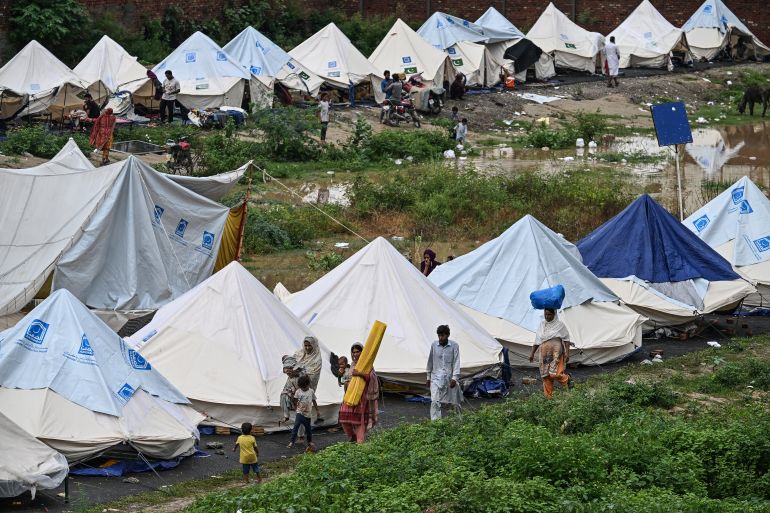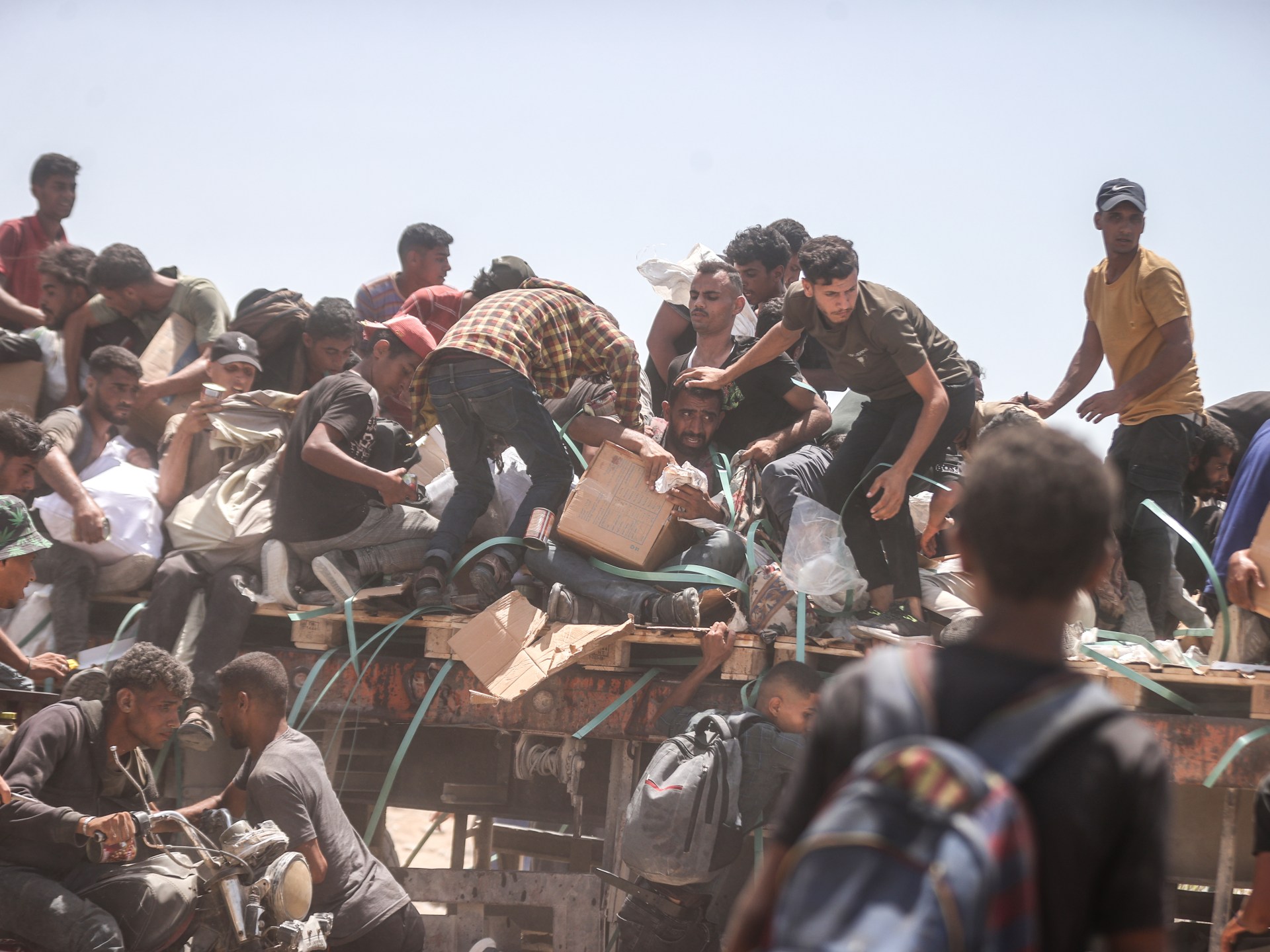Has India ‘weaponised water’ to deliberately flood Pakistan? | India-Pakistan Tensions News
Islamabad, Pakistan – For the second time in three years, catastrophic monsoon floods have carved a path of destruction across Pakistan’s north and central regions, particularly in its Punjab province, submerging villages, drowning farmland, displacing millions and killing hundreds.
This year, India – Pakistan’s archrival and a nuclear-armed neighbour – is also reeling. Its northern states, including Himachal Pradesh, Uttarakhand and Indian Punjab, have seen widespread flooding as heavy monsoon rains swell rivers on both sides of the border.
Recommended Stories
list of 4 itemsend of list
Pakistani authorities say that since late June, when the monsoon season began, at least 884 people have died nationally, more than 220 of them in Punjab. On the Indian side, the casualty count has crossed 100, with more than 30 dead in Indian Punjab.
Yet, shared suffering hasn’t brought the neighbours closer: In Pakistan’s Punjab, which borders India, federal minister Ahsan Iqbal has, in fact, accused New Delhi of deliberately releasing excess water from dams without timely warnings.
“India has started using water as a weapon and has caused wide-scale flooding in Punjab,” Iqbal said last month, citing releases into the Ravi, Sutlej and Chenab rivers, all of which originate in Indian territory and flow into Pakistan.
Iqbal further said that releasing flood water was the “worst example of water aggression” by India, which he said threatened lives, property and livelihoods.
“Some issues should be beyond politics, and water cooperation must be one of them,” the minister said on August 27, while he participated in rescue efforts in Narowal city, his constituency that borders India.
Those accusations come amid heightened tensions between India and Pakistan, and the breakdown of a six-decade-old pact that helped them share waters for rivers that are lifelines to both nations.
But experts argue that the evidence is thin to suggest that India might have deliberately sought to flood Pakistan – and the larger nation’s own woes point to the risks of such a strategy, even if New Delhi were to contemplate it.
Weaponising water

Relations between India and Pakistan, already at a historic low, plummeted further in April after the Pahalgam attack, in which gunmen killed 26 civilians in Indian-administered Kashmir. India blamed Pakistan for the attack and walked out of the Indus Waters Treaty (IWT), the transboundary agreement that governs the Indus Basin’s six rivers.
Pakistan rejected the accusation that it was in any way behind the Pahalgam attack. But in early May, the neighbours waged a four-day conflict, targeting each other’s military bases with missiles and drones in the gravest military escalation between them in almost three decades.
Under the IWT, the two countries were required to exchange detailed water-flow data regularly. With India no longer adhering to the pact, fears have mounted in recent months that New Delhi could either try to stop the flow of water into Pakistan, or flood its western neighbour through sudden, large releases.
After New Delhi suspended its participation in the IWT, India’s Home Minister Amit Shah in June said the treaty would never be restored, a stance that prompted protests in Pakistan and accusations of “water terrorism”.
But while the Indian government has not issued a formal response to accusations that it has chosen to flood Pakistan, the Indian High Commission in Islamabad has, in the last two weeks, shared several warnings of possible cross-border flooding on “humanitarian grounds”.
And water experts say that attributing Pakistan’s floods primarily to Indian water releases from dams is an “oversimplification” of the causes of the crisis that risks obscuring the urgent, shared challenges posed by climate change and ageing infrastructure.
“The Indian decision to release water from their dam has not caused flooding in Pakistan,” said Daanish Mustafa, a professor of critical geography at King’s College London.
“India has major dams on its rivers, which eventually make their way to Pakistan. Any excess water that will be released from these rivers will significantly impact India’s own states first,” he told Al Jazeera.
Shared monsoon strain
Both Pakistan and India depend on glaciers in the Himalayan and Karakoram ranges to feed their rivers. For Pakistan, the Indus river basin is a lifeline. It supplies water to most of the country’s roughly 250 million people and underpins its agriculture.

Under the IWT, India controls the three eastern rivers – Ravi, Sutlej and Beas – while Pakistan controls the three western rivers, Jhelum, Chenab and Indus.
India is obligated to allow waters of the western rivers to flow into Pakistan with limited exceptions, and to provide timely, detailed hydrological data.
India has built dams on the eastern rivers it controls, and the flow of the Ravi and Sutlej into Pakistan has considerably reduced since then. It has also built dams on some of the western rivers – it is allowed to, under the treaty, as long as that does not affect the volume of water flowing into Pakistan.
But melting glaciers and an unusually intense summer monsoon pushed river levels on both sides of the border dangerously high this year.
In Pakistan, glacial outbursts followed by heavy rains raised levels in the western rivers, while surging flows put infrastructure on the eastern rivers in India at serious risk.
Mustafa of King’s College said that dams – like other infrastructure – are designed keeping in mind a safe capacity of water that they can hold, and are typically meant to operate for about 100 years. But climate change has dramatically altered the average rainfall that might have been taken into account while designing these projects.
“The parameters used to build the dams are now obsolete and meaningless,” he said. “When the capacity of the dams is exceeded, water must be released or it will put the entire structure at risk of destruction.”
Among the major dams upstream in Indian territory are Salal and Baglihar on the Chenab; Pong on the Beas; Bhakra on the Sutlej; and Ranjit Sagar (also known as Thein) on the Ravi.
These dams are based in Indian-administered Jammu and Kashmir, Indian Punjab and Himachal Pradesh, with vast areas of Indian territory between them and the border.
Blaming India for the flooding in Pakistan makes no sense, said Shiraz Memon, a former Pakistani representative on the bilateral commission tasked under the IWT to monitor the implementation of the pact.
“Instead of acknowledging that India has shared warnings, we are blaming them of water terrorism. It is [a] simple, natural flood phenomenon,” Memon said, adding that by the end of August, reservoirs across the region were full.
“With water at capacity, spillways had to be opened for downstream releases. This is a natural solution as there is no other option available,” he told Al Jazeera.
Politics of blame

According to September 3 data on India’s Central Water Commission website, at least a dozen sites face a “severe” flood situation, and another 19 are above normal flood levels.
The same day, Pakistan’s Ministry of Water Resources issued a notification, quoting a message from the Indian High Commission, warning of “high flood” on the Sutlej and Tawi rivers.
It was the fourth such notice by India after three earlier warnings last week, but none contained detailed hydrological data.
Pakistan’s Meteorological Department, in a report on September 4, said on the Pakistani side, two sites on the Sutlej and Ravi faced “extremely high” flood levels, while two other sites on the Ravi and Chenab saw “very high” levels.
The sheer volume of water during an intense monsoon often exceeds any single dam or barrage’s capacity. Controlled releases have become a necessary, if dangerous, part of flood management on both sides of the border, said experts.
They added that while the IWT obliged India to alert Pakistan to abnormal flows, Pakistan also needs better monitoring and real-time data systems rather than relying solely on diplomatic exchanges.
The blame game, analysts warn, can serve short-term political purposes on both sides, especially after May’s conflict.
For India, suspending the treaty is framed as a firm stance against what it sees as Pakistan’s state-sponsored terrorism. For Pakistan, blaming India can provide a political scapegoat that distracts from domestic failures in flood mitigation and governance.
“Rivers are living, breathing entities. This is what they do; they are always on the move. You cannot control the flood, especially a high or severe flood,” academic Mustafa said.
Blaming India won’t stop the floods. But, he added, it appears to be an “easy way out to relinquish responsibility”.



